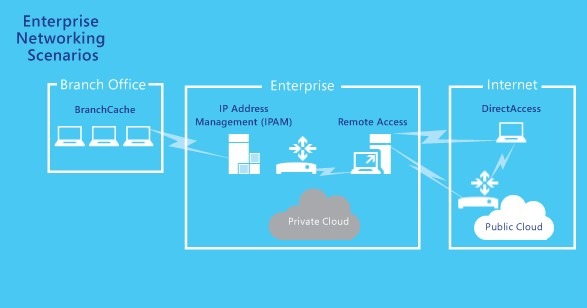In the era of the enterprise movement; you need to plan ahead of the access types that you are going to deliver to your users/customers etc. A SharePoint portal which has connectivity to your CBS or another form of application server can be used to deliver per user access in a form of Internet Banking, web based portals and so on. Since generic people will be using multiple types of handheld devices, and they will, how are you going to secure your network access while you will be troubled with access types, access devices variations as well. So, secure your transactional challenges and adapt quickly to access technologies to Enterprise Grade Solutions.
As the diagram depicts; this is just an imitation of Enterprise Access Design. You can also learn more about one of the other two main networking areas: Cloud Networking Technologies and Host Server Configurations, or get the overview of Networking Technologies.
With the Windows Server Networking technologies that are provided for enterprise networking scenarios, you can:
- Provide network access for remote users.
The Windows Server 2012 Remote Access server role that combines DirectAccess and the former RRAS allows for centralized administration, configuration, and monitoring of DirectAccess, Routing, and VPN-based remote access services. - Manage computer addressing and name resolution services.
IP Address Management (IPAM) in Windows Server 2012 is a new built-in framework for discovering, monitoring, auditing, and managing the IP address space used on a corporate network. IPAM provides for administration and monitoring of servers running Dynamic Host Configuration Protocol (DHCP) and Domain Name System (DNS).
Improve application and download performance for branch office locations.
To optimize wide area network (WAN) bandwidth when users access content on remote servers, BranchCache copies content from your main office or hosted cloud content servers and caches the content at branch office locations, allowing client computers at branch offices to access the content locally rather than over the WAN.
Networking Technologies
- BranchCache
- Domain Name System
- Dynamic Host Configuration Protocol
- Extensible Authentication Protocol
- High-Speed Networking
- Hyper-V Network Virtualization and Virtual Switch
- IP Address Management
- Internet Protocol security (IPsec)
- Network Policy and Access Services
- Quality of Service (QoS) and Data Center Bridging (DCB)
- Remote Access
- Server and Domain Isolation
- TCP/IP v4 and v6
- Windows Firewall
- Wired and Wireless Networking with 802.1X Authentication
- Deploy Remote Access in an Enterprise
- DirectAccess Capacity Planning
